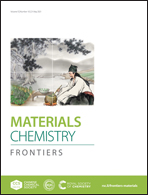Hydrogen bond induced high-performance quaternary organic solar cells with efficiency up to 17.48% and superior thermal stability†
Abstract
Multicomponent systems have been widely investigated to expand absorption spectra, ameliorate morphology and achieve high-performance organic solar cells (OSCs). Here, we reveal a novel quaternary OSC based on a PM6:Y6:SR197:PC71BM system with a power conversion efficiency (PCE) of up to 17.48%, one of the highest efficiencies in organic photovoltaics. The N–H bonds of SR197 react with the F atom of acceptor Y6 to form intermolecular hydrogen bonds that regulate the morphology of the blended film and inhibit bimolecular recombination, so that a PCE of 16.83% is achieved for the ternary OSC based on a PM6:Y6:SR197 system. However, the PCE of PM6:Y6:PC71BM-based devices is 16.72% due to the fullerene derivative PC71BM exhibiting strong isotropic transport ability. The quaternary OSC combines the advantages of the above two ternary devices, and it is noteworthy that SR197 can also form hydrogen bonds with PC71BM, which allows targeted morphology control and improved device stability while increasing photon utilization. Therefore, the efficiency of the quaternary device rose by 12% in contrast to the binary device (15.56%). Our results detail the use of a hydrogen bonding strategy to overcome the disadvantages of the difficult-to-control morphology of multiple component devices, which is a valid way to achieve high-performance quaternary OSCs.

- This article is part of the themed collection: 2021 Materials Chemistry Frontiers HOT articles


 Please wait while we load your content...
Please wait while we load your content...